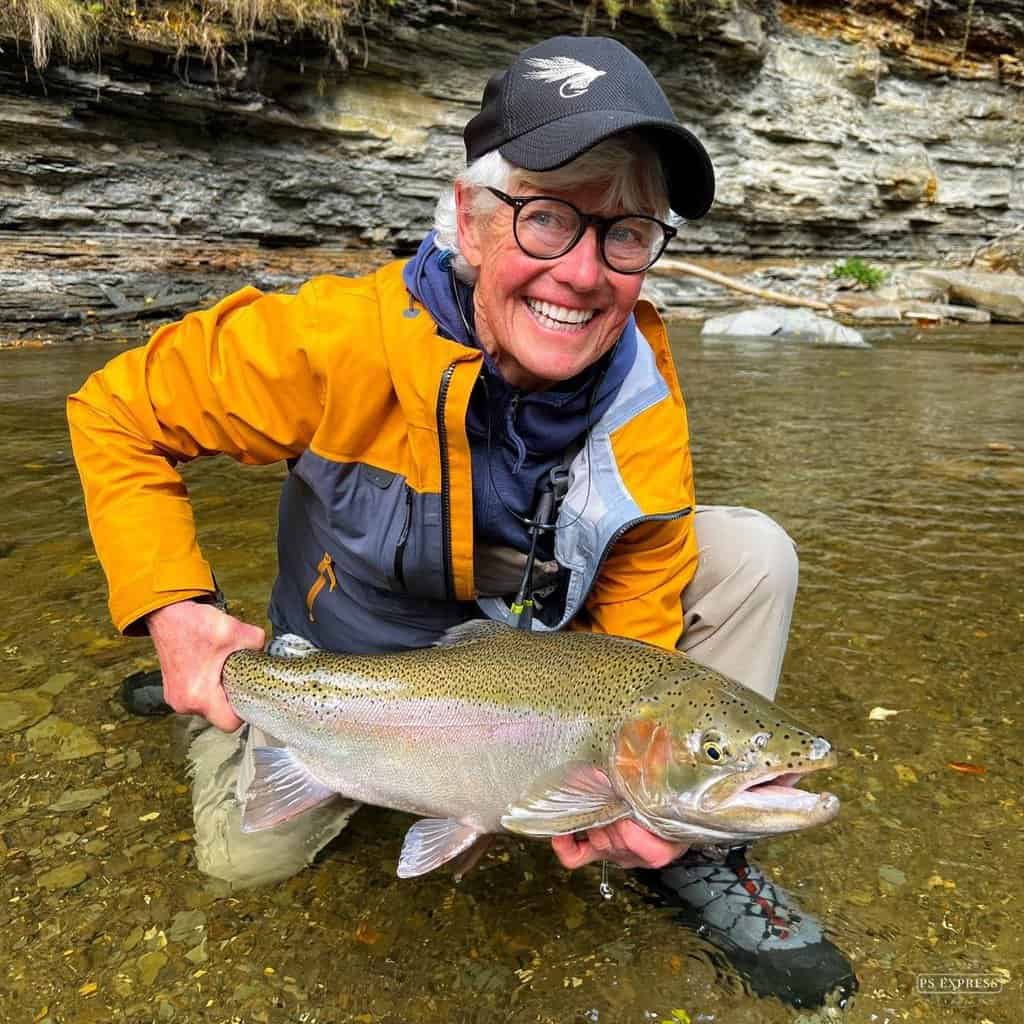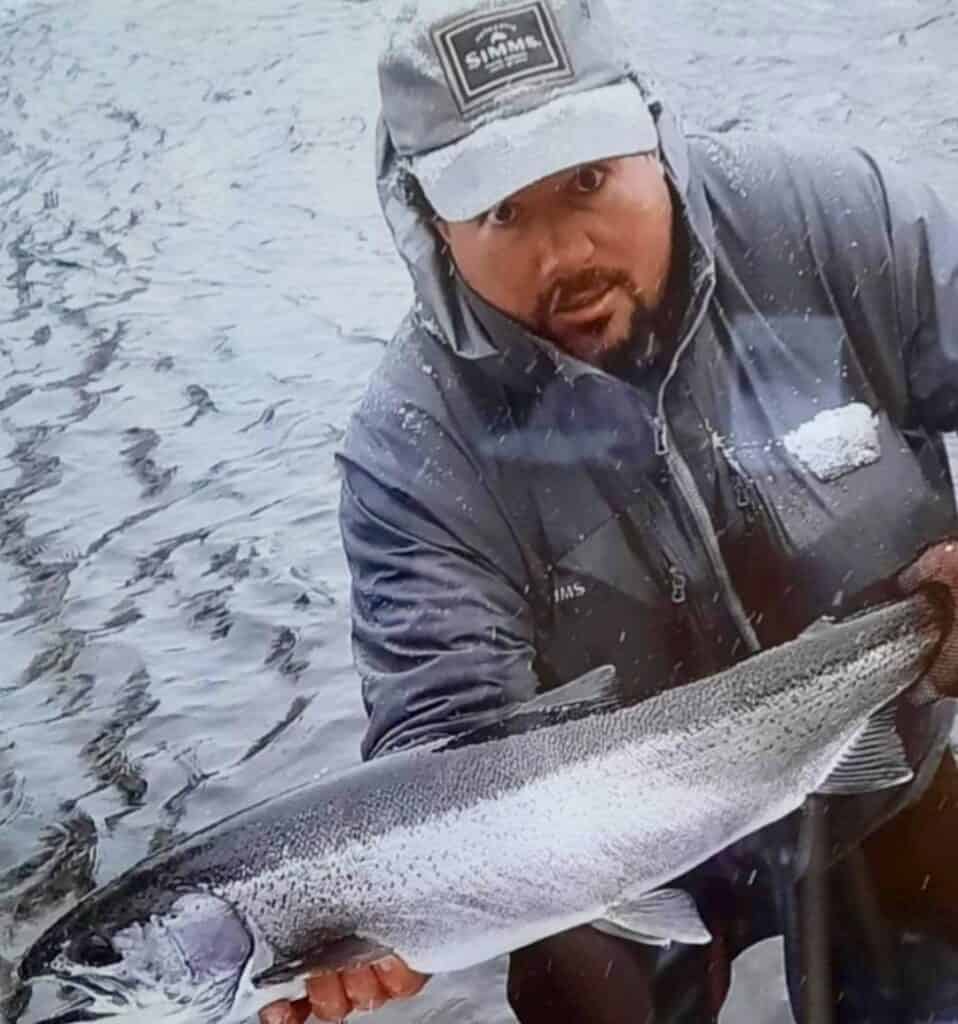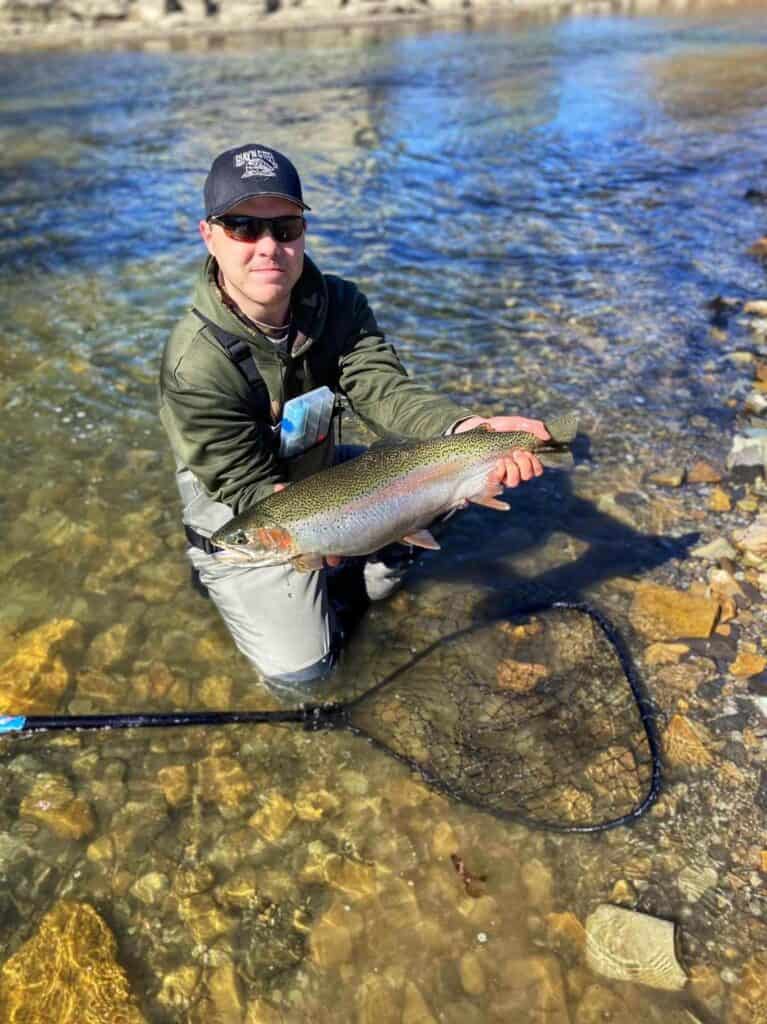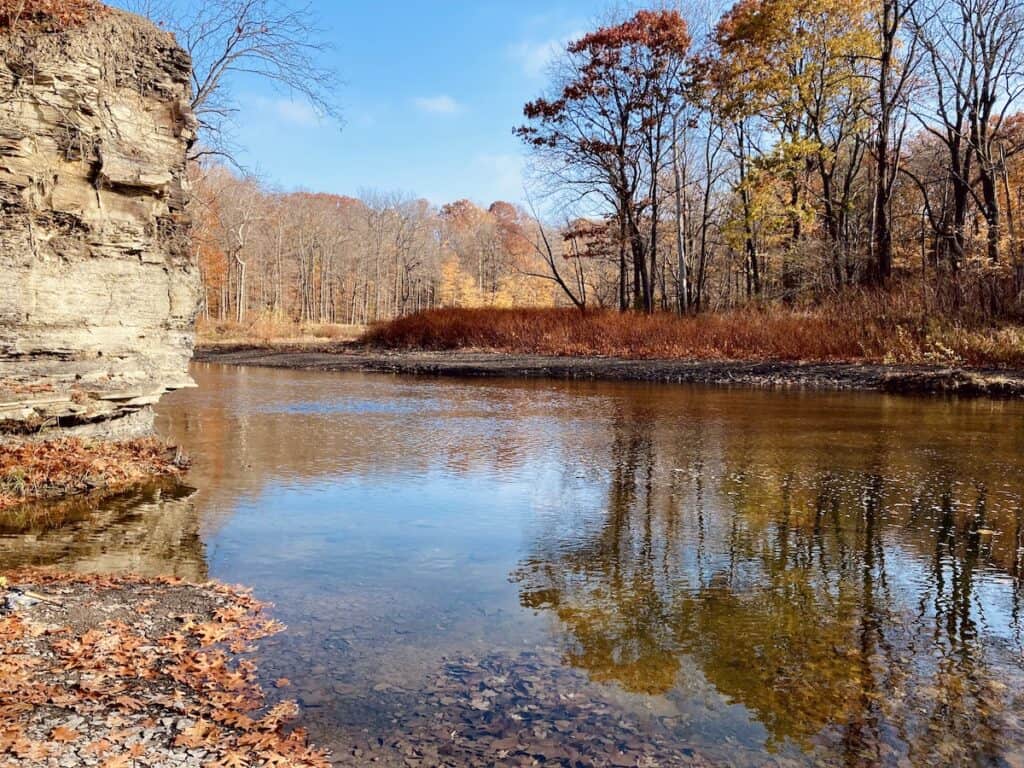Steelhead are a fish that inspires devoted anglers to brave freezing temperatures, pouring rain, and even snowstorms in Upstate New York for even an outside chance to catch one.
This article will show you the New York streams that give you the best odds of catching a steelhead or two.
New York’s population of these big migratory rainbow trout spend most of their lives fattening up in Lake Ontario and Lake Erie before returning to spawn in tributary streams where they were born or planted as hatchery-reared juveniles.
For this article, we spoke to three experts: longtime fishing guide Vince Tobia and steelhead fishing fanatics Josh Crandall and John Giovenco. These successful steelhead anglers shared some top tips on where and how to catch steelhead, one of New York’s toughest game fish to master.
Steelhead may appear in the worst weather conditions, powering upstream with barely enough water to cover their backs.
Steelhead are tough to find and even more challenging to catch until you know what you’re doing. So we’ll help you with that part.
Even when you hook one, it’s far from over. A steelhead may jump a dozen times and peel your line, racing upstream and down before you can finally bring it to the bank.
“They’re elusive, they put up an incredible fight, and they’re a great picture fish,” Crandall said of his favorite species.
New York Steelhead Fishing Primer
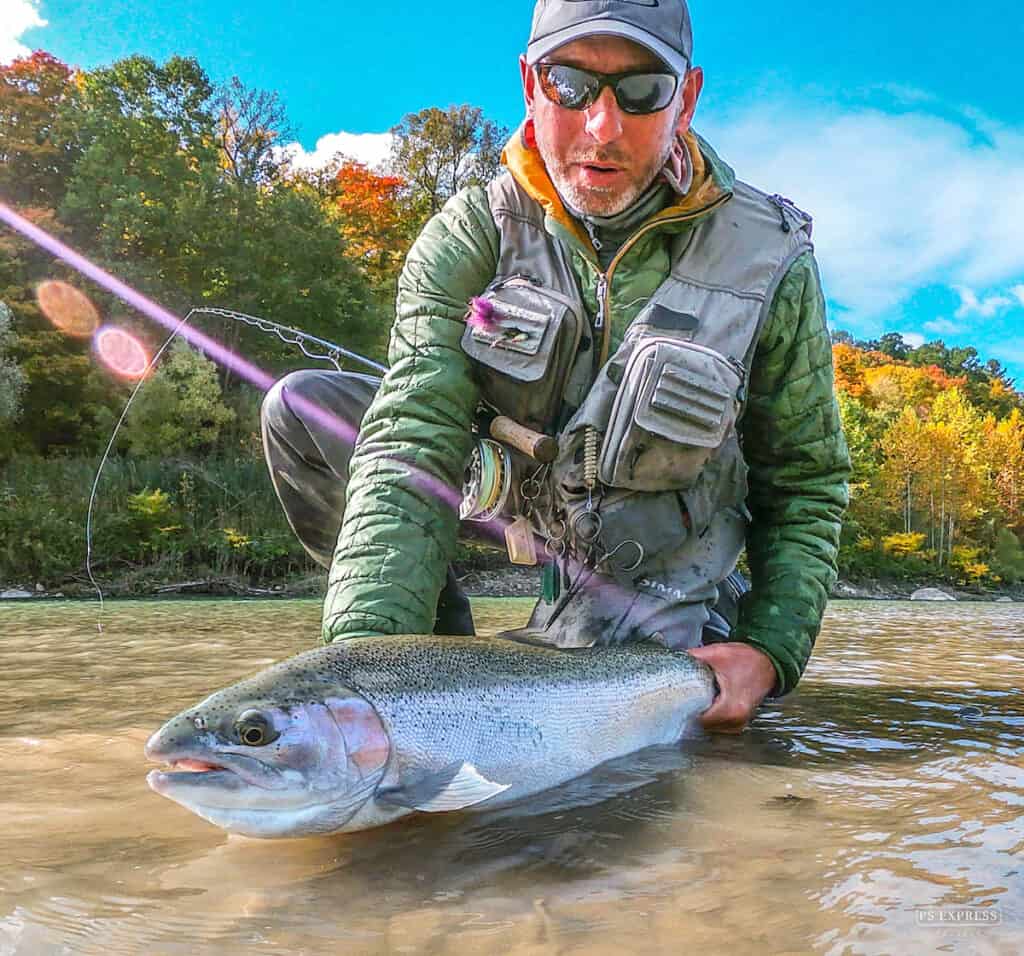
First, know that New York steelhead return to tributary rivers in two distinct runs.
You might catch either the winter-run fish, also locally called Washington steelhead, or the Skamania, a summer-run fish. Both strains are originally ocean-going steelhead from the state of Washington but have been well-established in the Great Lakes region for generations of anglers.
The Washington (winter-run) steelhead begin entering Lake Ontario tributaries following the run of king salmon, a.k.a. Chinook.
Despite being called winter runs (they run in winter in Washington state), in New York these bigger runs of steelhead typically show up in the fall and overwinter, often with a few arriving by about mid-September.
October and November can be incredible times to target these fish in the rivers before water temperatures dip below 40 degrees.
Winter steelhead spawn in the river systems in March and April before returning downstream and into the lake.
The “drop-back” fish will often heavily feed as they re-enter the lake, making for a great spring fishery in Western New York.
Skamania steelhead are stocked in the Salmon and Little Salmon rivers in the Lake Ontario watershed and Cattagaurus Creek in the Lake Erie watershed. They typically run before the larger winter-run fish and may appear from May through September.
These summer-run fish are less common than their cold-weather counterparts, so for most of the rivers we cover in this article, we’ll focus on the winter run, but know that similar tactics work for summer fishing where there are Skamania steelhead.
Anglers often size and tone down their lures and lines for lower-water conditions.
Heavy rains or dam releases in the summer can stimulate a run, so anglers who keep an eye on river levels can have a better shot at landing steelhead in the warmer months.
The Salmon River is one of the best-known and most crowded New York streams with a strong steelhead run. However, there are many lesser-known creeks where you can successfully target these fish. We’ll tell you about the best of all of them to give you options.
How to Catch Steelhead
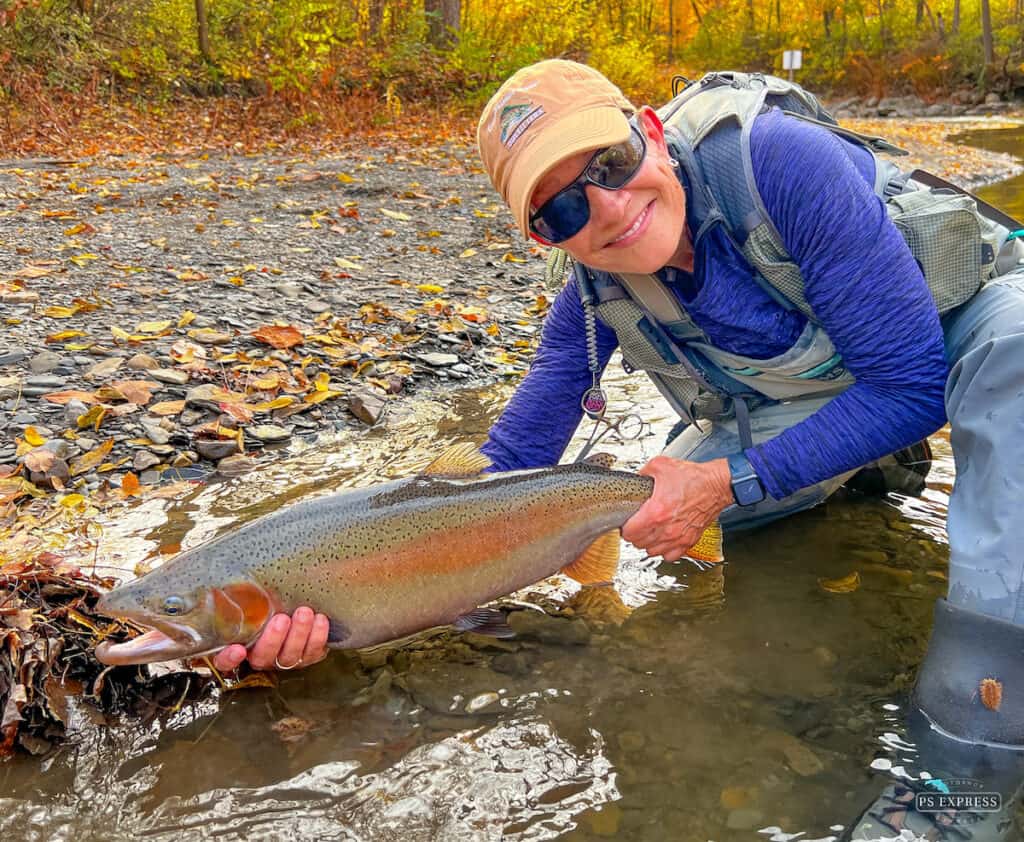
Steelhead Rods and Reels
Giovenco, who has fished for steelhead for close to 40 years, recommended a 9- to 10-foot spinning rod with a medium or larger spinning reel capable of holding at least 200 yards of 10-pound-test monofilament.
Giovenco himself typically uses 8-pound-test monofilament line, so as not to spook these line-wary fish. However, less-experienced anglers might want to err on the side of caution, using lines ranging from 10- to 14-pound test.
Fly anglers will need a rod of between 9 and 11 feet paired with a complementary reel capable of holding a seven-weight, weight-forward floating fly line and plenty of backing.
The key with a large-arbor fly reel, Giovenco says, is that it can retrieve line faster if these fish start running at you.
Steelhead Flies, Lures and Bait
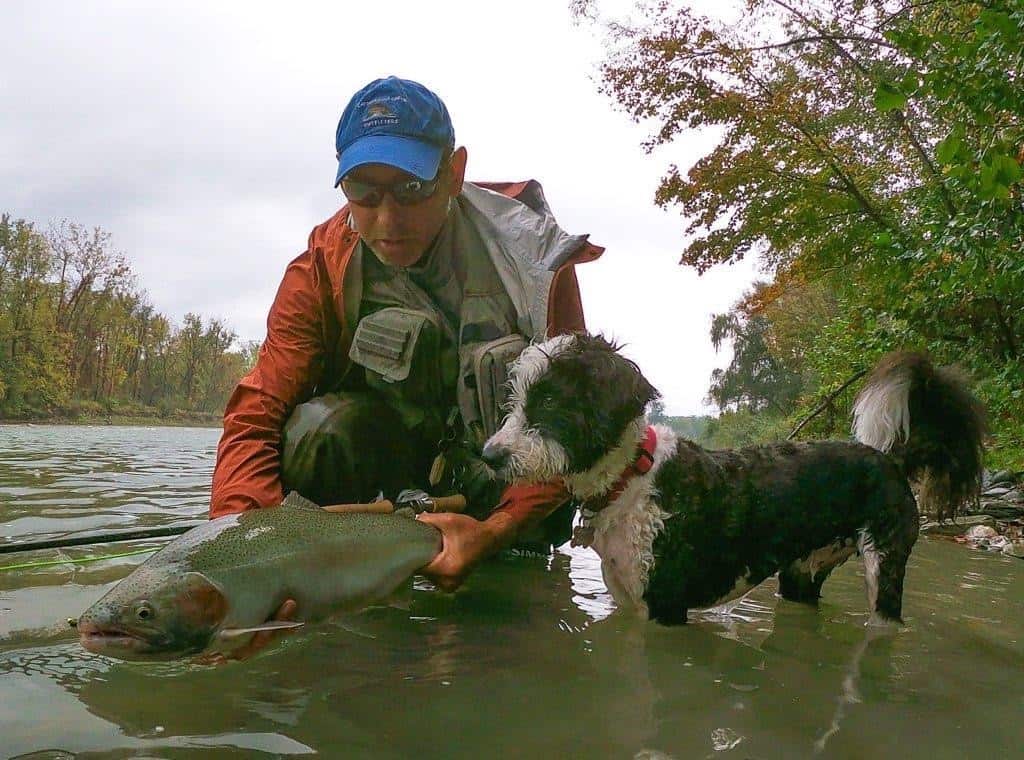
You’ve got to hook the fish before you can fight them, though. That’s where fly and lure selection comes into play.
Giovenco says that egg patterns and attractor patterns work well for the fly fishing set, naming colors like Oregon Cheese, Peach, and pink as particular favorites.
Crandall, a former Bass Pro Shops employee who has fished for steelhead himself for about a decade and has e other anglers get in on his favorite sport, uses an 8-weight, weight-forward floating line while fly fishing.
However, Crandall very often uses his 13-foot centerpin rod and reel loaded with monofilament line.
Crandall prefers egg patterns in the “Salmon River blue” shade, sold at Pineville Sporting Supply in Pulaski, which is near the Salmon as well as several other steelhead streams.
Tobia, the fishing guide over on the Lake Erie side, said that he and clients regularly catch steelhead on nymphs, egg patterns in the fall, and on Hare’s Ears, stone flies, and pheasant tails.
He’ll scale down as small as size 16 nymphs when the water is low and clear. Wooly buggers in olive, white, black and brown are popular, too.
“In November, leeches, nymphs, like a stone fly nymph, a chartreuse caddis with a black head, or soft hackle flies like a black pheasant tail become more popular,” Giovenco says.
As mentioned, Crandall often uses a centerpin rod and reel to go after steelhead.
You can think of a centerpin as a combination of a spinning setup and a fly combo. A centerpin reel resembles a fly reel, but its larger arbor holds monofilament line.
Centerpin rods are typically longer than their fly fishing counterparts. The entire idea behind the setup is to achieve a drag-free drift, much as a fly fisherman would, but with monofilament.
If you decide you would like to go more in-depth on catching steelhead after reading this article, we’ve linked our full guide to steelhead fishing at the bottom.
When to Catch Steelhead
Giovenco fishes Lake Ontario tributaries including the Salmon River, South Sandy Creek, and the Oswego River.
He says that cloudy days are best for catching steelhead. However, days after heavy rain in the fall will often be most productive, as fish use increased flows to push upriver.
Crandall agreed, saying that overcast days in the 50-degree range are ideal, adding that too much sun will make the fish harder to hook.
Once the salmon have spawned, Crandall suggested fishing marabou jigs with waxworms on the hook for the spinning rod set.
Black stoneflies are a great option for fly anglers after the salmon eggs are gone.
As the water cools below 50 degrees, the fish become more lethargic and harder to entice.
“January is the worst month to try to hook one. If you know where the holes are, you can find them, but the trick is getting them to hit,” Crandall said.
He said he’ll keep changing his presentation when he knows there are fish until he lands on something that works.
Best Steelhead Fishing Streams in New York
If you plan to chase steelhead in the state, here are some streams worth investigating in New York’s two Great Lakes watersheds, along with a few tips for each location.
Lake Ontario Tributaries
These streams feed into Lake Ontario, which provides a rich source of food that allows these lake-run rainbows to reach salmon-like proportions.
These tributaries include some of New York’s most famous steelhead fishing rivers.
Salmon River
When it comes to steelhead fishing in New York, this is the big one. The Salmon River draws anglers from around the state and across the Northeast.
First, get to know the regulations, which change depending on where you plan to fish this river.
An “upper fly zone” is regulated for fly fishing only.
A stretch called the D.S.R. (for Douglaston Salmon Run) is privately owned. Anglers must wear a wristband to show that they’ve paid to fish that section.
The Salmon River gets the largest runs of salmon and steelhead of just about any river in the state. If you’re traveling to fish and targeting steelhead specifically, this is your best bet.
Well-known pools including the Ballpark Pool and Trestle Pool, are shown on this DEC map. Study that map a bit, so if you overhear tackle-shop chatter about good spots, you’ll know what they mean.
The Salmon River also shines as one of the better places to catch brown trout in New York.
Oak Orchard Creek
If you talk to enough steelhead anglers in western New York, you’ll hear the name Oak Orchard again and again. That’s because, aside from the Salmon River, Oak Orchard Creek is one of the most productive steelhead streams in the state.
Steelhead have four miles of river to run up from Lake Ontario before they hit a dam.
The stretch immediately below the dam is the best bet for shore-bound anglers. The dam is just below the intersection of Waterport Carlton Road and Eagle Harbor Waterport Road in Waterport.
Twelve Mile Creek
This stream near Wilson offers another potentially great stretch of water for anglers plying Lake Ontario’s steelhead runs.
The strength of steelhead runs into many smaller streams like Twelve Mile Creek depends on water levels and rainfall with each season. However, Twelve Mile can have strong runs of steelhead as well as brown trout when water conditions are right.
The best steelhead fishing can be found in the lower section of Twelve Mile Creek from Braley Road near the town of Ransomville down to the lake.
Wilson Tuscarora State Park runs along the east side of the stream right at its mouth at Lake Ontario, and offers a boat ramp and shore fishing platform.
Twelve Mile Creek and its East Branch, which also flows into Ontario near the state park, offer state-protected access along their banks.
Oswego River
The Oswego River is another larger stream that’s a popular spawning site for Lake Ontario steelhead.
One added benefit of fishing the Oswego is that the state has added concrete walkways with railings. The Oswego can be a good bet for anglers just starting out or wary of wading.
The Varick Dam on the Oswego is a popular spot for wading anglers. A siren alerts fishermen of impending dam releases so they can step out before the water level rises.
Sandy/Little Sandy Creek
Sandy Creek flows into North Sandy Pond, a large pond with a mouth that opens into Lake Ontario north of Pulaski.
Although access is more difficult to find here overall, there is a fishing access point off Lake Street in the community of Sandy Creek a few miles up Little Sandy Creek.
The creek offers about 10 miles of unobstructed runs for steelhead. I have seen these fish caught even in the pond itself, so runs can be plentiful in certain years.
Genesee River
The Genesee River flows into Lake Ontario right near the city of Rochester.
Steelhead have several miles of the river to run before reaching a barrier.
Not far below Lower Falls, Seth Green Island sits mid-river. This island area can be shallow enough to wade and fish, depending on rainfall and water levels.
Seth Green is a popular spot for shore-bound anglers because it can see large numbers of fish and is not far from downtown Rochester.
Sterling Creek
If you’re superstitious and like saving money, how about a Lake Ontario tributary that begins in a town called Victory and flows right through a campground where you can stay if you time it right.
The Sterling Creek watershed can have strong runs of steelhead every year.
There’s a canoe and kayak launch off Farden Road in the town of Sterling, if you want to access more of the stream.
The mouth of the creek enters Lake Ontario in Fair Haven Beach State Park.
The state park is a popular destination in the summer, thanks to its huge sandy bluffs.
Camping is available from spring to early fall. However, note that the campground does close in mid-October when the run is likely going, but it reopens in April, with time left for spring steelhead fishing.
One bonus with fishing Sterling Creek is that a dam, about three miles up from Lake Ontario, blocks steelhead passage. You’re targeting steelhead in a relatively confined area.
Grindstone Creek
Near the town of Mexico, one of the state’s most famous salmon fishing towns, Grindstone Creek flows into Lake Ontario in the Selkirk Shores State Park.
One positive element about Grindstone is that it’s one of the smaller streams with a good steelhead run.
It averages just 25 feet across along its course up to a dam that stops steelhead in Fernwood.
For anglers who’d like to get to their stretch of water with a little less adventure, the state park offers four parking areas within walking distance to the stream.
Niagara River
One of the most incredible fisheries in Western New York has to be the Niagara River, and its annual runs of bright, fierce steelhead is a big reason why. Unlike the other bodies of water on this list, the Niagara is a big but relatively short tributary that connects both of New York’s Great Lakes, Erie and Ontario.
Steelhead can run up the Niagara River from Lake Ontario until they reach the famous Niagara Falls, which is impassable to fish.
The entire river sits along the border of Canada and the United States, so it’s a place to pay attention to regulations and beware of wrong turns coming and going.
Earl W. Brydges Artpark and Devil’s Hole state parks sit along the New York bank of the river and offer some of the better angler access.
State officials warn that strong currents and slippery rocks can make fishing conditions hazardous depending on the weather, so take care. The Fort Niagara and Joseph Davis state parks are closest to where the river enters Lake Ontario.
For older and younger anglers, or anyone with a difficult time walking over potentially dangerous terrain, the New York Power Authority offers a fishing platform seasonally open to the public.
A long net might be required to get your fish to the deck above river level. If you are successful, this facility also has a fish cleaning station.
Anglers can find parking areas near S. 4th Street, Portage Road in Lewiston, at the Joseph Davis State Park, the Whirlpool State Park, and the Devil’s Hole State Park.
The Niagara River also is an excellent spot to catch other game fish, including some of New York’s best river fishing for smallmouth bass and even some giant muskies.
More: Complete Guide to Niagara River Fishing
Lake Erie Tributaries
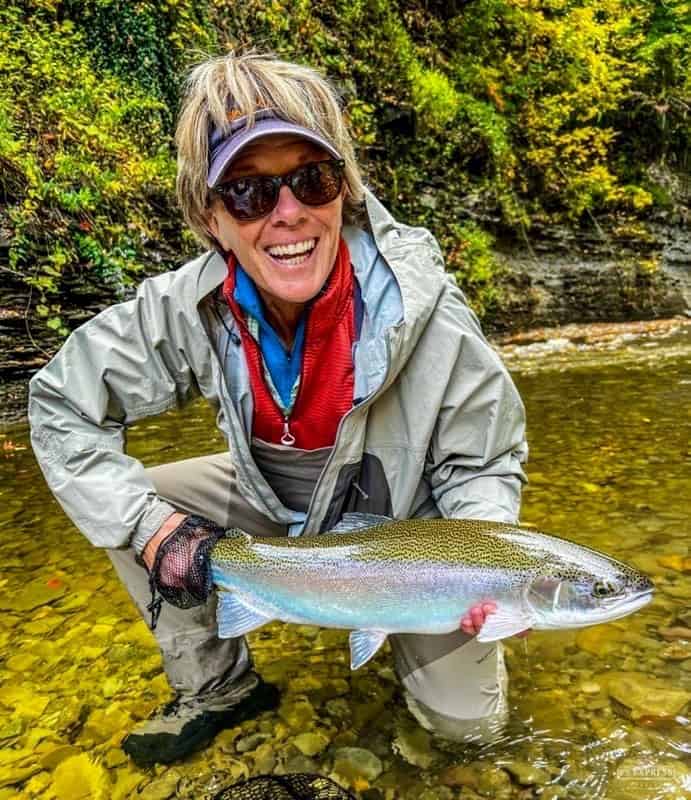
Although the Salmon River near Pulaski sees more steelhead traffic than anywhere else in the state, it’s far from the only stream where you can find these fish.
Head west for Lake Erie tributaries that are definitely worth your attention, and can be far less crowded.
Cattaraugus Creek
Cattaraugus Creek is fishing guide Vince Tobia’s home stream, as you might guess from his business name, Cattaraugus Creek Outfitters.
“There are some remote sections where you could convince someone they were in Alaska if you were just dropped in.” That’s not a comparison Tobia makes blindly, as he has fished in Alaska, the Bahamas, and Montana.
Cattaraugus Creek is partly known for its wild steelhead, which exist alongside the state-stocked fish.
“The Cattaraugus is great, that’s our favorite,” he said.
The bulk of the steelhead run reaches Cattaraugus in October, although fish will start trickling in by about mid-September.
Nights that drop into the 40s and 50s and autumn rains push most of the fish through in October.
The DEC also stocks juvenile Skamania steelhead into Cattaraugus Creek, which gives anglers a shot at catching these magnificent fish in much better weather. While the Skamania runs can be more fickle, late summer has the best potential.
Because Cattaraugus is one of the larger Erie tributaries on the New York shoreline, it can be more challenging. That’s because there are 34 miles of water to fish.
The average steelhead on the Cattaraugus is between 25 and 30 inches.
October and November and again in March and April (for the drop-back fish) are their main steelhead seasons. However, a mild December can make for great fishing as well.
Tobia said one advantage to fishing this stream in November is that steelhead will spread through the length of the stream. In October, steelhead tend to stack up at the mouth.
Farther upstream, Cattaraugus Creek is one of New York’s best trout streams.
More: Complete Fishing Guide to Cattaraugus Creek
Canadaway Creek
Canadaway Creek is a popular steelhead tributary that flows into Lake Erie near Dunkirk.
Canadaway also is known for the brown and brook trout stocked every year.
However, the main draw between October and December is the steelhead. Where it first meets Erie, the Canadaway Creek Nature Sanctuary protects the stream from development.
The sanctuary is a nice feature for those who prefer a scenic backdrop to your steelhead photos. Small natural waterfalls offer a gorgeous setting.
The stream has about six miles of water with steelhead.
Chautauqua Creek
Near the town of Barcelona, Chautauqua Creek is another legendary New York steelhead stream.
One beneficial element about Chautauqua Creek is that, at 15 miles long, it gives anglers more room to spread out and search for active fish than some other streams on our list.
Please note that certain sections of the stream are catch-and-release-only, so be sure to check New York Department of Environmental Conservation regulations before heading out.
Another intriguing element about Chautauqua Creek is that it flows through the 538-acre Chautauqua Gorge State Forest.
The forest offers picnic tables, fire rings, and public parking for anglers planning a trip. On the downside, the forest is open seasonally, so pay attention to the schedule and other regulations.
Anglers can also find a public access point near the corner of Fort Street and Touring Route 21 in Westfield.
Like most of the Erie tributaries on our list, you’ve also got a good shot at catching spawning brown trout on Chautauqua in the fall in addition to steelhead.
Eighteen Mile Creek
One important draw of Eighteen Mile Creek just south of Buffalo is great access. Thanks to the Eighteen Mile Creek County Park, more than two miles of the stream are accessible to anglers.
Just before the creek crosses S. Creek Road in Hamburg, there’s a waterfall impassable for steelhead. The barrier stops steelhead and makes narrowing down the section of the stream you should fish downstream from the falls that much easier.
The town of North Evans has the most protected fishing access along the main stem of the stream, but where it branches off into its South Branch, there are angler access areas off Belknap Road as well.
If you like the stream and want to return at other times of the year, Eighteen Mile Creek also features good smallmouth fishing in the spring and early summer.
Walnut Creek
Another promising steelhead stream near Silver Creek is Walnut Creek.
The Village of Silver Creek Park offers good public access for steelhead anglers.
In fact, Walnut Creek has nearly 8 miles of stream that anglers can access without trespassing, giving it more public fishing opportunities than any stream in Chautauqua County.
Cayuga Creek
This Cayuga Creek is a Lake Erie tributary with good stretches of public access, including in the Como Lake Park upriver.
Cayuga Creek is a major tributary of the Buffalo River, joining Buffalo Creek to form the river flowing through Buffalo.
The Cayuga tributary gets relatively reliable steelhead runs every year.
Summary
New York anglers have a wide variety of streams and rivers to choose from when targeting these incredible fish.
A steelhead’s strength and beauty draw fishermen to New York from all over the Northeast every year.
If you find yourself on a steelhead stream or river this season, we hope the above information is helpful, and we wish you luck.
Catch More Steelhead
Be sure to check out our complete but simple-to-follow guide with more steelhead fishing tips and techniques.
Acknowledgements
Thanks again to Josh Crandall, John Giovenco, and Vince Tobia for sharing their New York steelhead fishing expertise and photographs.
The New York Department of Environmental Conservation also was another valuable source of information about steelhead fishing in the state, especially its guides and maps to Lake Ontario steelhead tributaries and Lake Erie steelhead tributaries.

